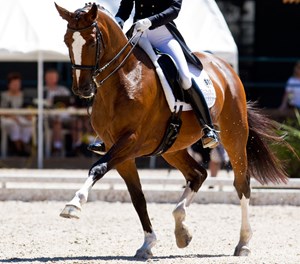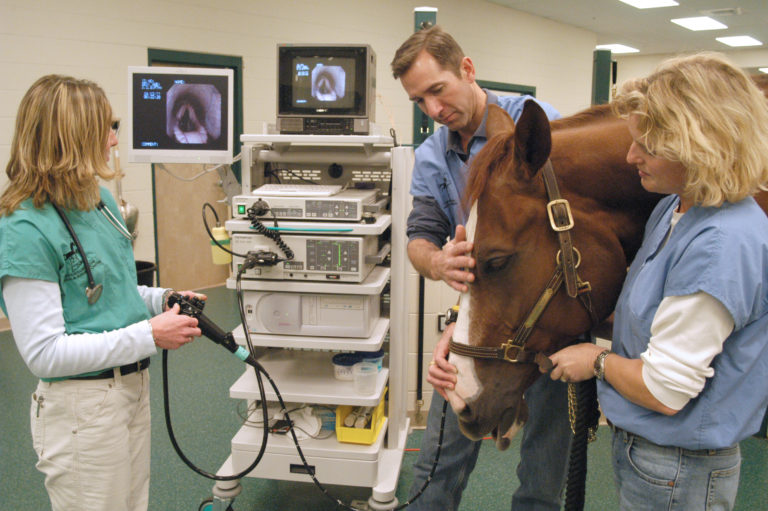
I love riding the extended trot on my dressage horses. When I ask my Grand Prix dressage horse Alina to move into an extended trot as she straightens onto the diagonal, it feels like it is her idea, a controlled explosion with maximum confidence. An extreme combination of fully loaded carrying and thrusting power, the extended trot is absolutely fantastic to ride.
While Alina’s rectangular shape makes her well-suited for the movement, her extended trot is the result of a training framework that builds flexibility and impulsion in any dressage horse. When I first met Alina four years ago, she was a Young Rider’s dressage horse with plenty of fire and a great work ethic. I bet that as she developed better looseness and carrying power, I could channel her desire to go while we developed her ability to collect and extend. It was a gamble that’s now paying off in the extended trot.
In schooling for the extended trot then and now, we focus on exercises that require a lot of thrust from the hindquarters and collecting exercises that require her to carry more weight on her hindquarters, hence playing the two ends of the spectrum. As a result, her range has widened to achieve an extended trot that takes your breath away.
Here are some training techniques that will help you safely expand your horse’s range and teach him to perform the extended trot as if he’s thrilled to show off his ability to do what the Federation Equestre Internationale (FEI) refers to as a lengthening of his steps to the utmost of his capability.
Working Gaits with Integrity
As the cornerstone of dressage training, the working gaits create the basis for developing the qualities and reactions needed for collection and extension. I focus on creating and maintaining my horse’s flexibility, rhythm and impulsion as I warm up in working gaits. I want to feel and reward natural enthusiasm for work, and spending time in the working gaits really helps.
One of the integral ingredients in producing extension is impulsion. The following simple daily warm-up will help set up any horse, from Training Level to Grand Prix, with the all-important desire to go forward and stay relaxed while doing it. It includes schooling simple upward and downward transitions on circles to teach the horse that every transition should have a basic level of carrying and thrusting power.
Try transitions by following these steps:
1. Establish your 20-meter circle in a steady, active, rhythmic working trot. Make sure the shape of your circle is correct. This forces you to control the horse’s lateral balance. If you make a wishy-washy circle, you give him permission to fall in or off the track. Anytime impulsion goes left or right instead of straight through the horse’s body, you lose forward power, like a garden hose full of holes. Control and channel all of your horse’s power in a specific direction. Also make sure you have the correct bend, which starts with correct flexion. Crest muscles should be positioned so that they fall to the inside and you can see the horse’s inside eye. His jaw should be loose and accepting of the bit.
2. As you prepare for an upward transition to canter, think about riding with the lightest-possible aids. I know that my horse is truly in front of my seat when it takes next to nothing to change gears.
3. Switch from rising to sitting trot by putting weight on your inside seat bone and whispering “canter” with your inside leg.
4. As you canter, gently increase the swing of your seat, backed up by your leg, voice and whip (if needed), to achieve a prompt increase in the volume of your horse’s gait.
5. Transition back into working trot with the use of your outside rein. Half halt while maintaining flexion and bend to the inside. Continue to encourage and reward enthusiastic forward motion without loss of rhythm.
Continue with these transitions while adding changes of direction until your horse is loose, warm and happy in both his desire to go forward and in his willingness to wait on your downward transitions. There is some magic in this simple exercise to freshen the lazy horse, relax the hot horse and loosen the back and neck structure of all horses.
Coil the Spring
Once your horse can make seamless transitions on the circle in a good rhythm and maintain a relaxed posture, the rest of your session should include any of a limitless number of exercises that build both thrusting and carrying power. Any exercise that you choose based on your horse’s current level of training should incorporate a sense of “coiling the spring.” Here is one way that I do it:
1. Frequently check that the horse has the desire to go forward in an instant. I do this by deliberately swinging my seat while imagining that my horse is increasing the volume of his movement. As I think “forward,” I let my fingers “breathe” and allow for slight lengthening of his frame. I follow through on my original driving aids with an invisible aid, using my upper calf, lower leg, spur, voice and whip in that order. When your horse understands this aid sequence, his sensitivity to the more subtle aids increases, and he helps you by being self-propelled.
2. Check the collecting aids. The basic collecting aid is the half halt. For me, that’s closing my knee and thigh, stabilizing my back and seat, vibrating my fingers and thinking that I want my horse to coil back toward his hind legs. The important point here is that my horse reacts by shifting his weight over his back into his croup and closing the joints of his hind legs. Just as with the driving aids, I must follow through on the collecting aids. If my horse doesn’t react clearly and efficiently to this initial aid, I do three things: Repeat the original aid and, if need be, promptly make a stronger aid. Second, make a downward transition. Third, transition to halt.
By reinforcing my horse’s willingness to promptly expand and contract (like a rubber band), I increase his sensitivity to both aids and I expand his range of motion between collection and extension, coiling the spring.
Extended Trot Transitions
This is one of my favorite exercises for developing great collected-extended-collected trot transitions. The idea is to use your horse’s natural desire to please and his ability to anticipate. I learned it from dressage icon Conrad Schumacher about 15 years ago. It’s a very simple exercise that rewards a horse for beginning to explore the outer boundaries of his range.
1. Start out in working trot, tracking on the long side of the arena.
2. Walk at the letter before the corner, maintaining a good bend.
3. Promptly make half a walk pirouette to the left, which turns you back to the same wall, facing the other way.
4. Using the lightest-possible aids, straighten your horse and transition back to the working trot.
5. Before you get to the corner, transition to walk and make half a walk pirouette to the right. Stay on the long side, heading in the other direction.
Repeat the exercise, asking for more during the trot on the long side. First, ask for a lengthening of the working trot and then for more extension, each time with an easy downward transition to walk and then the half walk pirouette to turn around.
This exercise highlights one of the extremes of collection, which is the collected walk required for a walk pirouette. Perfecting this will help you transition to an extended trot because the horse must remain active in the hind legs and do so with a correct bend. The pirouettes give you a moment to gather confidence, establish balance and reward the horse for thinking in the right direction.
In the process, you form the horse as you focus on the integrity of your position to maintain looseness, bend and flexibility. This allows your driving aids to flow through the horse’s back to maintain the looseness that keeps the energy flowing.
It is also important to remember that the extended trot is not all that natural to many horses. In nature most horses will run away from danger by galloping. Occasionally, you will see loose horses start to extend their trot, but they usually break to canter because it is simply easier and more efficient. Because of this, it is imperative that you build your horse’s strength slowly and methodically, work on excellent footing, be judicious about the repetitions of extensions and, as always, finish your sessions when you know that your horse has done the best he could on that day. In addition, remember that rewarding your horse is critical to his mental and physical well-being and understanding. During moments of success, tell your horse that he did it right with an encouraging voice and a relaxed but supporting body.
To improve extension in the trot at any level, experiment with how far you and your horse can go out of your comfort zone to improve, like a singer training her vocal cords to reach the limit of her range. On one end of the spectrum, how far can your horse extend? On the other end of the spectrum, how close can he get to ultimate collection?
Before you take these questions to the ring, make sure your horse is sound and well-shod, that you have good help on the ground and you’re working on at least moderately good footing. Take an honest look at the qualities built into your horse. It’s only fair to ask him to improve according to his specific range of capabilities, which are influenced by his breed, psyche, conformation, age, fitness and training. This is true of all horses at every level.
Arlene “Tuny” Page is an international dressage rider and trainer. Her top competition mounts are the 13-year-old Danish mare, Alina, and Wild One, her 15-year-old Danish gelding. She is also campaigning 10-year-old Ice Cup, who will compete in his first Grand Prix in early 2012. Page owns Stillpoint Farm in Wellington, Florida. The facility is home to internationally recognized riders, including Robert Dover and Oded Shimoni. Page has trained with Klaus Balkenhol, Kyra Kyrklund and Hubertus Schmidt. In 2006, she was the U.S. freestyle champion and the U.S. representative to the FEI World Cup and an alternate to the 2006 World Equestrian Games team. In 2007, she represented the United States at CHIO Aachen in Germany. Page serves the dressage community on the U.S. Equestrian Team Foundation Board of Trustees and the U.S. Equestrian Federation High Performance and Active Athlete Committees.











